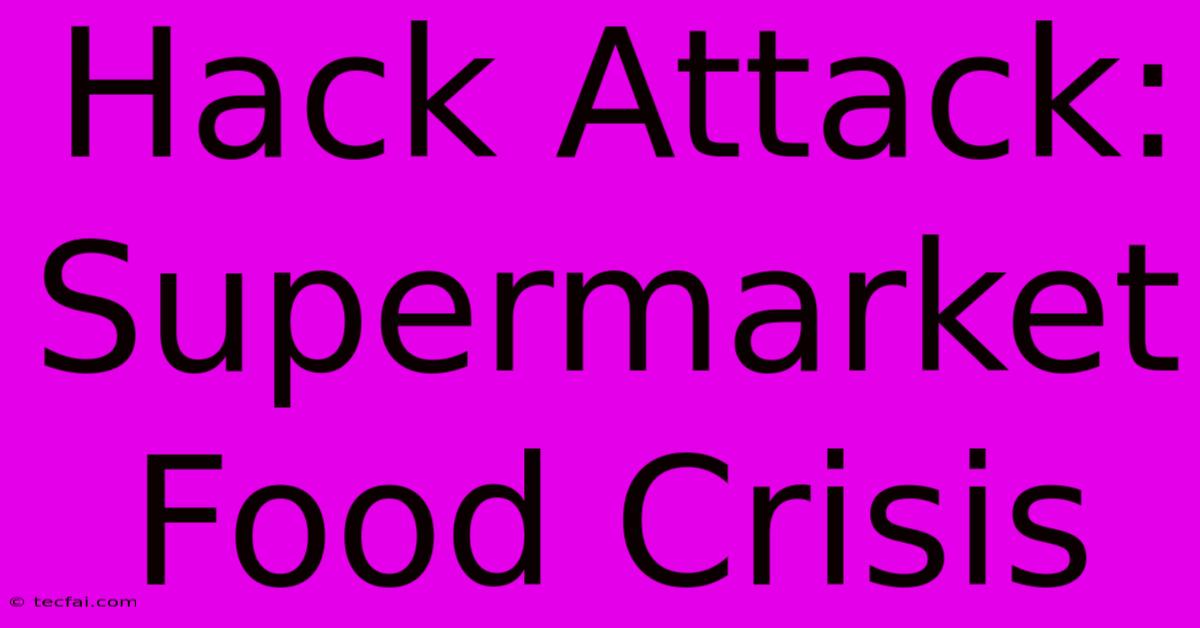Hack Attack: Supermarket Food Crisis

Discover more detailed and exciting information on our website. Click the link below to start your adventure: Visit Best Website tecfai.com. Don't miss out!
Table of Contents
Hack Attack: Supermarket Food Crisis – Are We Prepared?
The modern supermarket, a seemingly invincible bastion of readily available food, is surprisingly vulnerable. A recent surge in cyberattacks targeting the food supply chain has raised serious concerns about the potential for a widespread food crisis. This isn't about empty shelves due to supply chain disruptions, but something far more insidious: a potential collapse caused by sophisticated hacking. Let's delve into the vulnerabilities and the looming threat.
The Weak Links in the Supply Chain
Supermarkets rely on a complex network of interconnected systems. From farm-to-fork, every stage—farming, processing, transportation, warehousing, and finally, the supermarket itself—is vulnerable to cyberattacks. These attacks can manifest in various ways:
1. Targeting Farms and Production Facilities:
- Data breaches: Hackers could steal sensitive information like crop yields, planting schedules, and livestock data, disrupting production and potentially manipulating markets.
- Sabotage of equipment: Controlling automated systems within farms and processing plants through malware could lead to spoiled crops or halted production lines, causing significant shortages.
- Ransomware attacks: Crippling these facilities with ransomware, demanding payment to restore operations, directly impacts food availability.
2. Disrupting Transportation and Logistics:
- GPS manipulation: Hacking GPS systems on delivery trucks could reroute shipments, causing delays or complete loss of perishable goods.
- Supply chain disruptions: Cyberattacks on logistics companies managing transportation networks could lead to major bottlenecks and delays.
- Data manipulation: Hackers could alter inventory records, leading to inaccurate stock levels and inefficient distribution.
3. Compromising Supermarket Systems:
- Point-of-sale (POS) system attacks: Hacking POS systems could lead to data breaches of customer information and disruption of payment processing, potentially leading to store closures.
- Inventory management system attacks: Compromised inventory systems could cause inaccurate stock levels, leading to shortages and inefficiencies.
- Refrigeration system attacks: Malicious code targeting refrigeration systems could cause spoilage of massive quantities of food, leading to significant waste and shortages.
The Severity of the Threat
The potential consequences of a large-scale cyberattack on the supermarket food supply chain are dire. We're not just talking about inconvenience; we're talking about:
- Food shortages: Localized or widespread shortages of essential food items.
- Price hikes: Increased demand and reduced supply would lead to dramatic price increases, impacting vulnerable populations the most.
- Public health concerns: Spoiled food due to compromised refrigeration could lead to foodborne illnesses.
- Social unrest: Food insecurity can fuel social unrest and instability.
Mitigation Strategies: A Call to Action
The threat is real, and proactive measures are crucial:
- Enhanced cybersecurity: Investing in robust cybersecurity infrastructure across the entire food supply chain is paramount. This includes regular security audits, employee training, and the implementation of advanced security technologies.
- Improved data protection: Implementing strong data encryption and access control measures is crucial to protect sensitive information.
- Collaboration and information sharing: Increased collaboration between government agencies, businesses, and cybersecurity experts is needed to share threat intelligence and coordinate responses.
- Emergency preparedness: Developing contingency plans to mitigate the impact of cyberattacks is vital. This includes having backup systems, alternative supply routes, and communication strategies.
- Public awareness: Educating the public about the vulnerability of the food supply chain and the importance of cybersecurity is crucial.
Conclusion: Preparing for the Inevitable
A major cyberattack on the supermarket food supply chain is not a matter of if, but when. The time for complacency is over. By proactively addressing the vulnerabilities and implementing robust mitigation strategies, we can significantly reduce the risk of a catastrophic food crisis. The future of our food security depends on it.

Thank you for visiting our website wich cover about Hack Attack: Supermarket Food Crisis. We hope the information provided has been useful to you. Feel free to contact us if you have any questions or need further assistance. See you next time and dont miss to bookmark.
Featured Posts
-
Six Suspects In Coyotes Player Assault
Nov 27, 2024
-
Holyrood Snp Departures Rise
Nov 27, 2024
-
Aberdeen Fc No Alcohol In Fan Zone
Nov 27, 2024
-
Elizabeth Line Disruption Impacts Commuters
Nov 27, 2024
-
Oxford United 0 3 Sheffield United Match Report
Nov 27, 2024
